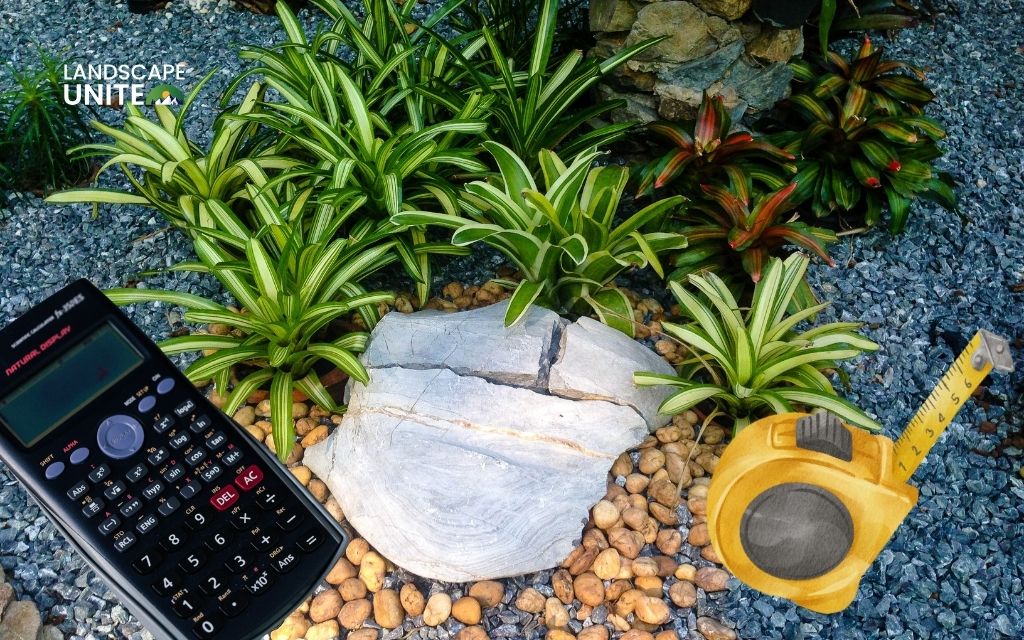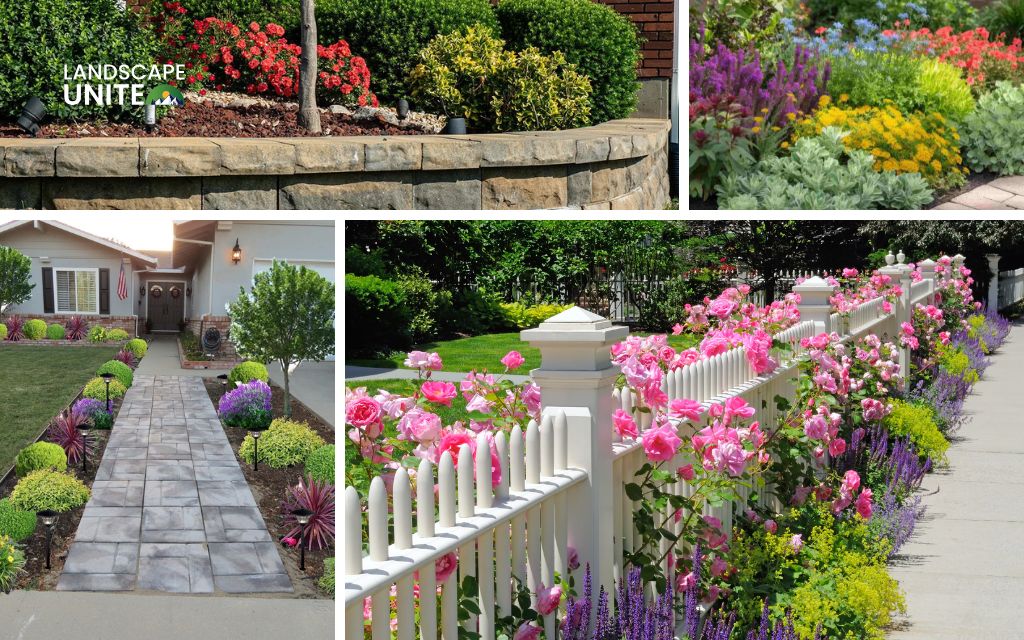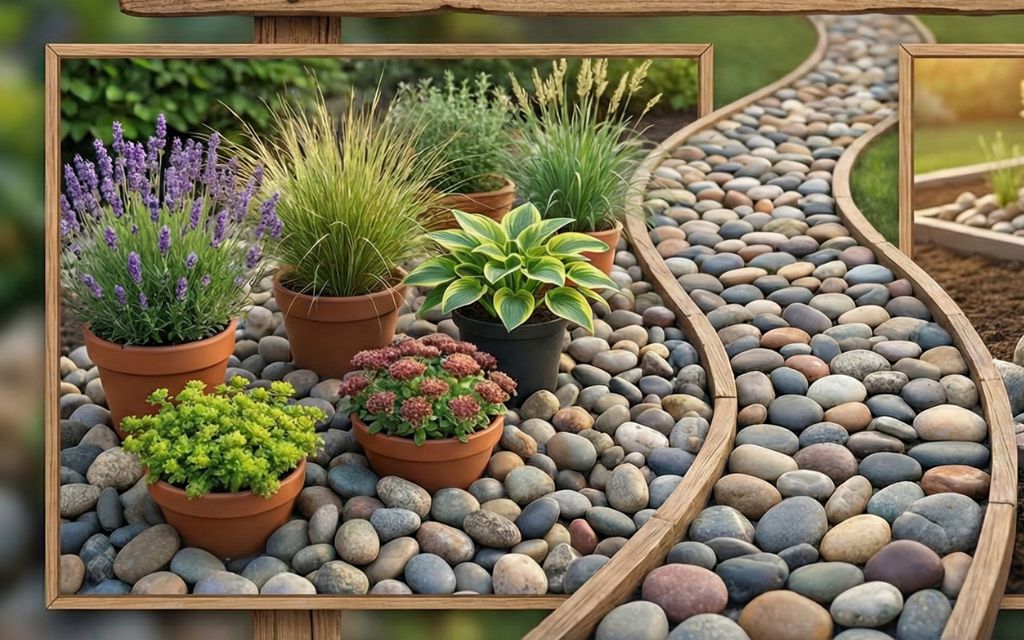Want to refresh your flower bed without digging everything up?
Many garden enthusiasts find themselves staring at flower beds that lack height, visual structure, or dynamic contrast – leaving their outdoor spaces feeling flat and one-dimensional.
The solution is simpler than you might think: using pots in your flower beds adds instant texture, seasonal flexibility, and year-round visual interest without major renovation work.
This comprehensive guide will show you exactly why and how to use containers effectively in your flower bed designs, complete with 10 beautiful and beginner-friendly design ideas that will transform your garden into a stunning outdoor showcase.
Using pots in flower beds: Why?
Integrating containers into your flower bed design offers numerous advantages that can elevate your garden’s appeal and functionality:
- Visual interest: Pots add height variation and create focal points. They break up the horizontal plane of traditional ground-level plantings, creating a more dynamic and layered landscape design.
- Seasonal flexibility: Container plants can be easily swapped out throughout the year, allowing you to maintain continuous color and interest.
- Better drainage: Many specialty plants require excellent drainage that heavy clay soils or poorly draining areas can’t provide. Containers offer the perfect solution for growing plants like lavender, succulents, or Mediterranean herbs that thrive in well-draining conditions.
- Pest and disease control: Container plantings isolate vulnerable plants from soil-borne diseases, root rot issues, and certain pest problems. This protective barrier allows you to grow sensitive plants, even in areas where they might struggle when planted directly in the ground.
How to incorporate pots into your flower beds
Successfully integrating containers into your flower bed design requires thoughtful consideration of both pot selection and strategic placement.
Choosing the right pots
Material selection significantly impacts both aesthetics and plant health.
- Terracotta pots offer classic appeal and excellent breathability for root systems, though they require protection in freezing climates.
- Ceramic containers provide durability and come in countless colors and finishes, making them ideal for creating cohesive design themes.
- Resin pots offer lightweight convenience and weather resistance while mimicking natural materials like stone or wood.
- Natural stone containers deliver unmatched durability and timeless elegance but require careful consideration of weight and placement.
Size and scale relationships are crucial for achieving professional-looking results. Large containers work best as focal points or anchor pieces, while smaller pots excel in groupings or as supporting elements.
Most importantly, make sure that every container has adequate drainage holes. Without proper drainage, even the most beautiful arrangements will fail due to waterlogged roots and plant death.
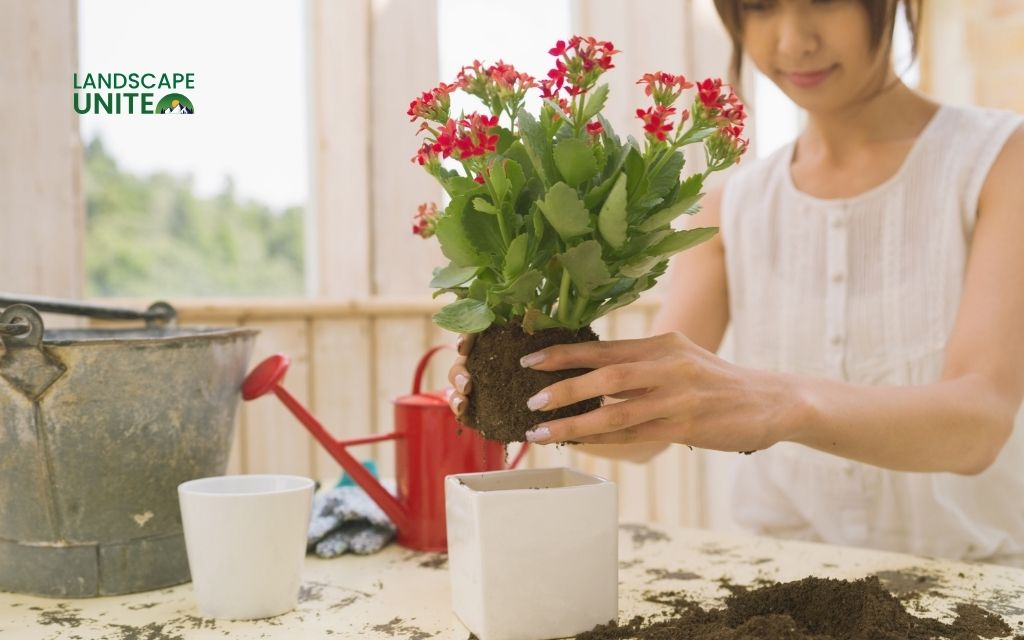
Placement tips
- Use odd-numbered groupings (3, 5, or 7 containers) to create natural, visually pleasing arrangements that feel organic rather than forced or institutional.
- Add elevation using plant stands, pedestals, or decorative blocks to create varied heights within your groupings. This layering technique adds depth and prevents shorter containers from disappearing behind taller plants.
- Always consider the mature size and light requirements of both container and ground plants when positioning pots.
- Avoid placing large containers where they’ll cast shade on low-growing, sun-loving plants nearby, and ensure adequate spacing for air circulation around all plantings.
Best plants for pots in flower beds
Plant selection makes or breaks container arrangements, and understanding sun requirements is fundamental to success.
For sunny locations
Petunias deliver continuous blooms in vibrant colors from spring through fall, while calibrachoa offers delicate flowers with trailing habits perfect for pot edges.
Lavender provides aromatic foliage and purple flower spikes that attract beneficial pollinators, and ornamental grasses like fountain grass or blue fescue add movement and textural contrast.
For shaded areas
For shaded areas, hostas offer incredible foliage diversity in colors ranging from deep green to chartreuse to blue-gray, with variegated options providing additional visual interest.
Impatiens bloom reliably in shade with colors spanning the spectrum, while coleus delivers stunning foliage in combinations of red, green, purple, and yellow that rivals any flower display.
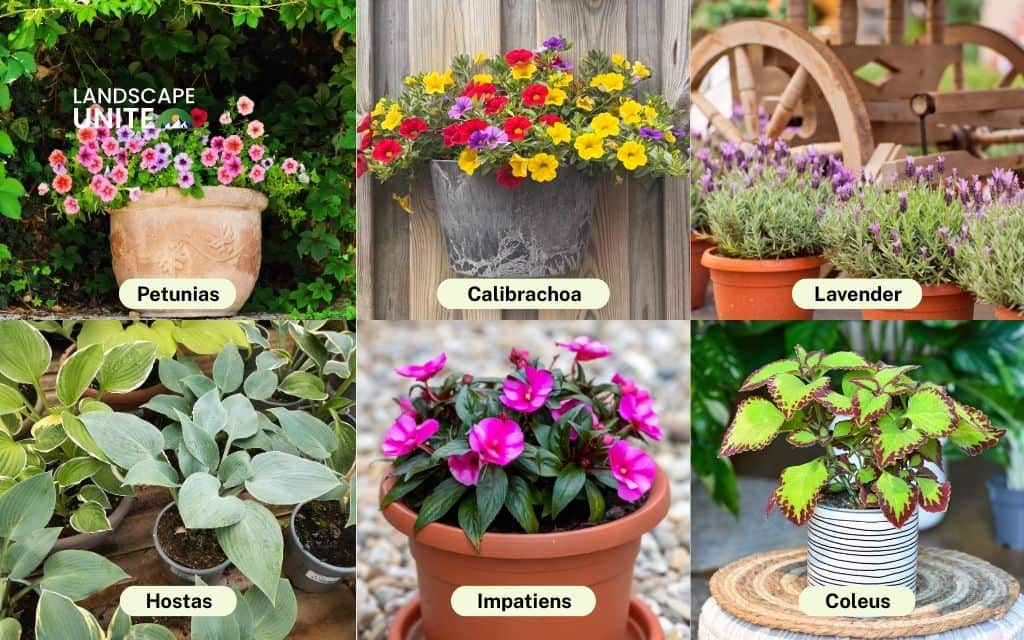
“Thriller, filler, spiller” formula
Master the “thriller, filler, spiller” formula for creating balanced, professional-looking arrangements.
- The thriller serves as your centerpiece – typically a tall, upright plant like a small ornamental tree, dramatic grass, or bold flowering plant.
- Fillers occupy the middle space with mounded or bushy plants that add fullness.
- Spillers cascade over pot edges, softening hard lines and creating graceful transitions to ground-level plantings.
Play with foliage textures and flower colors to create dynamic contrast within and between containers. Combine broad-leafed plants with fine-textured grasses, smooth leaves with fuzzy or serrated edges, and bold flower colors with subtle foliage tones for maximum visual impact.
10 Creative pot ideas for stunning flower beds
Transform your flower beds with these inspiring container design concepts:
Terracotta cluster
Group 3 – 5 terracotta pots of varying heights to create layered dimension and rustic charm. Mix sizes from small 6-inch pots to large 14-inch containers, filling each with plants that complement your existing flower bed colors while adding height variation.
Elevated centerpiece
Feature one large, dramatic container as the focal point in the center of your flower bed. Choose a substantial pot (18+ inches) and fill it with show-stopping plants like ornamental grasses, small trees, or bold flowering perennials that create a strong vertical element.
Color echoing
Select container colors that either match or create pleasing contrasts with your flower colors. Blue pots amplify orange marigolds, while white containers make purple petunias pop. This technique creates color harmony throughout your garden design.
Mosaic or painted pots
Add personal artistic flair with hand-painted designs or mosaic tile work. Create patterns that reflect your home’s architecture or garden theme, turning functional containers into unique art pieces that enhance your outdoor décor.
Vertical stacking
Use multi-tiered plant stands or create your own vertical arrangements to maximize growing space in compact areas. This technique works especially well for herb gardens or collections of small flowering plants.
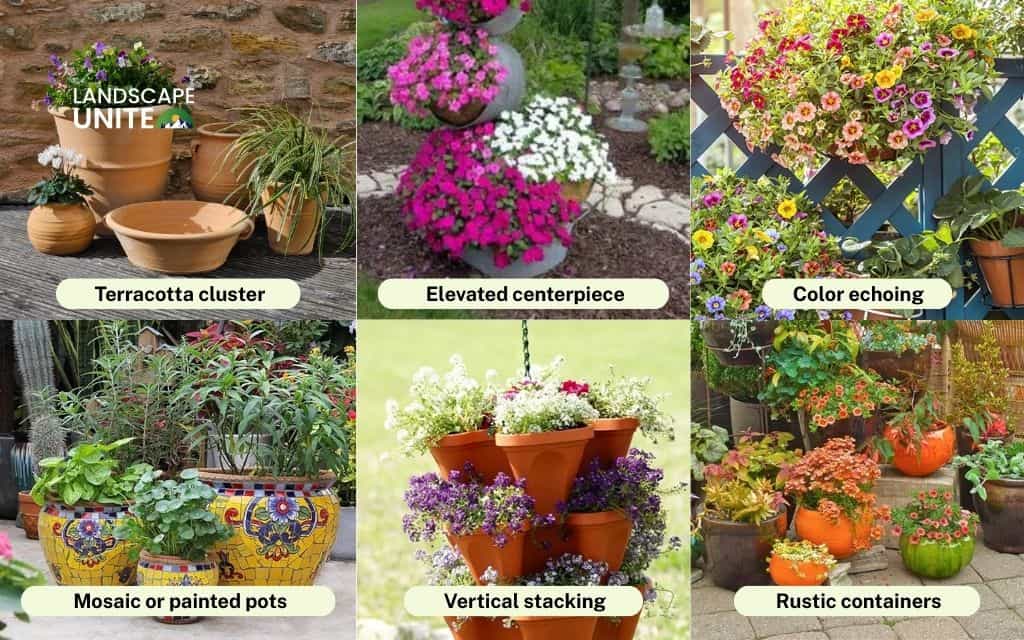
Rustic containers
Repurpose wooden crates, galvanized buckets, or vintage containers for authentic farmhouse appeal. These unexpected containers add character while providing excellent growing conditions for casual plantings like wildflowers or cottage garden favorites.
Symmetrical pairs
Place matching containers on either side of garden paths, steps, or entrances to create formal balance and guide visitors through your garden space. This classic design principle adds structure and elegance to any landscape.
Mix textures
Combine different pot materials – smooth ceramic with rough stone, sleek metal with natural wood – to create visual interest through contrasting textures. This approach adds sophistication and prevents monotonous container arrangements.
Mini herb corner
Cluster smaller pots filled with culinary herbs like basil, thyme, oregano, and parsley in one corner of your flower bed. This creates both beauty and function, providing fresh ingredients while adding fragrance and attracting beneficial insects.
Light-up pots
Incorporate solar-powered LED containers or add string lights around pot groupings for magical nighttime ambiance. This extends your garden’s appeal into evening hours and creates enchanting outdoor entertainment spaces.
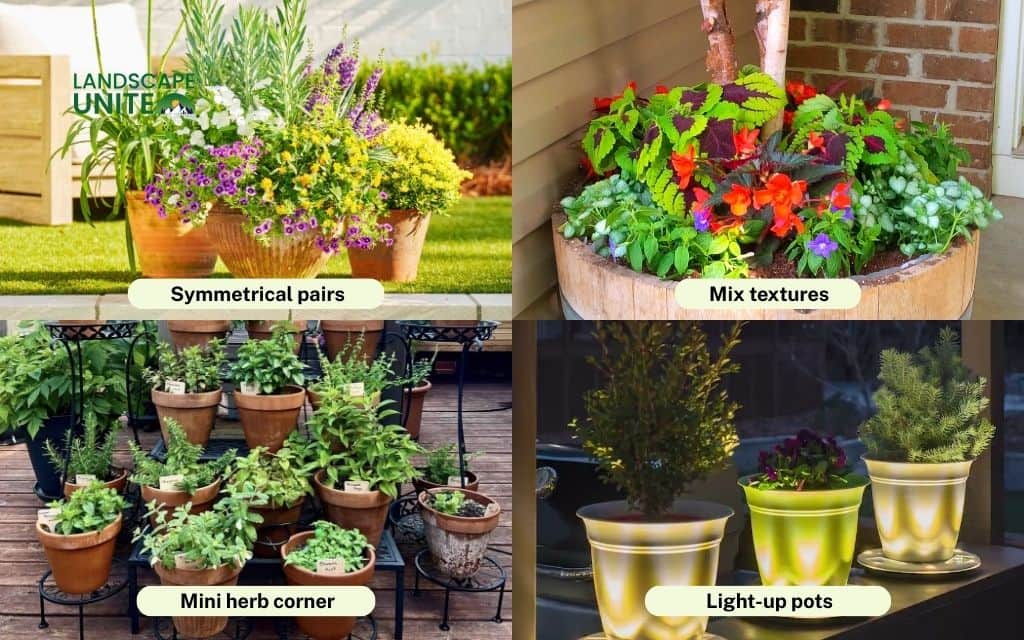
Pot maintenance tips
Successful container gardening requires consistent attention to several key maintenance areas.
- Water needs vary significantly between container plants and ground plantings, so check soil moisture frequently by inserting your finger 1 – 2 inches into the soil. Container plants typically need more frequent watering, especially during hot weather, but avoid overwatering which can be just as damaging as drought stress.
- Fertilize container plants regularly since frequent watering leaches nutrients from potting soil faster than from garden beds. Apply liquid fertilizer every 2 – 3 weeks during the growing season, or incorporate slow-release granular fertilizers at planting time for season-long nutrition.
- Rotate pots periodically to ensure even sunlight exposure and prevent plants from becoming lopsided as they grow toward their light source. This simple practice promotes balanced, attractive plant development.
Wipe containers clean occasionally to remove algae, mineral deposits, or dirt buildup that can detract from their appearance. Clean pots not only look better but also allow you to monitor for cracks or damage that might affect plant health.
Conclusion
Incorporating pots into your flower beds is one of the most effective ways to add instant visual appeal, seasonal flexibility, and design sophistication to your garden without major renovations.
From simple terracotta clusters to dramatic elevated centerpieces, these container strategies offer endless possibilities for creating dynamic, eye-catching landscapes that reflect your personal style.
Start with just one or two of these design ideas and watch how containers transform the entire look and feel of your outdoor space. Remember, successful container gardening is about experimentation and finding what works best for your unique garden conditions and aesthetic preferences.
Ready to take your garden design to the next level? Explore our extensive collection of landscape and gardening articles for more inspiration, seasonal guides, and expert tips. Your dream garden is just a few creative ideas away!
Frequently asked questions (FAQs)
Can pots stay outside all year long?
Most pots can remain outdoors year-round, but success depends on your climate zone and pot material. Terracotta and ceramic pots may crack in freezing temperatures, so consider moving them to protected areas or wrapping them for winter. Resin and high-quality stone containers typically handle temperature extremes better.
What pot materials last best in the elements?
Natural stone, high-fired ceramic, and quality resin containers offer the best weather resistance. Fiberglass and composite materials also perform well outdoors. Avoid thin plastic pots which become brittle in UV light, and protect terracotta in freezing climates.
How to arrange pots in a flower bed?
Use odd numbers of containers, vary heights for visual interest, and consider the mature size of both container and nearby plants. Create triangular arrangements rather than straight lines, and leave adequate space for plant growth and maintenance access.
Should I change the soil between seasons?
Replace or refresh potting soil annually for best results. Container soil becomes compacted and depleted over time, reducing drainage and nutrient availability. You can refresh existing soil by mixing in fresh compost and slow-release fertilizer.
Do plants do better in pots or in the ground?
Ground planting generally provides more stable growing conditions, but containers offer advantages for drainage-sensitive plants, seasonal displays, and situations where soil quality is poor. Container plants require more attention to watering and fertilizing.
What flowers grow well together in pots?
Choose plants with similar water and light requirements for successful combinations. Classic pairings include petunias with sweet alyssum, geraniums with trailing ivy, and marigolds with dusty miller. Consider bloom times, mature sizes, and growth habits when planning combinations.
